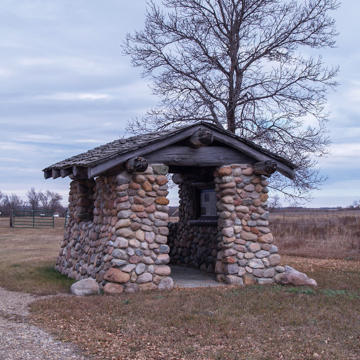The Menoken Indian Village Site, also known as the Verendrye Site, is the archaeological site of a village of earthen homes that was occupied from the thirteenth century onward. Between twenty and thirty earthlodges are generally enclosed by a four-bastion palisade on the inside of a fortification ditch. The site covers about three acres on a terrace adjoining the southeast side of an old meander loop of Apple Creek. The protected site conveys the appearance of a temporary summer campsite of Late Plains Woodland people who camped here repeatedly over a long precontact period. Early historians believed that this site was the isolated, fortified Mandan village visited by French explorer Pierre Gaultier de Varennes, sieur de La Vérendrye in a 1738 expedition. Recent scholarship has essentially disproven this theory, although the site was clearly active for several centuries before La Vérendrye’s explorations. Deferential fieldstone and timber features by the State Historical Society in the 1930s (CCC work relief projects) have helped protect and interpret this National Historic Landmark site.
You are here
Menoken Indian Village State Historic Site
13th century; 1780–1845; 1930s interpretive features. Exit 170 N, I-94, 1.5 miles northeast of Menoken
If SAH Archipedia has been useful to you, please consider supporting it.
SAH Archipedia tells the story of the United States through its buildings, landscapes, and cities. This freely available resource empowers the public with authoritative knowledge that deepens their understanding and appreciation of the built environment. But the Society of Architectural Historians, which created SAH Archipedia with University of Virginia Press, needs your support to maintain the high-caliber research, writing, photography, cartography, editing, design, and programming that make SAH Archipedia a trusted online resource available to all who value the history of place, heritage tourism, and learning.


















